Intangible heritage
Elements of the Intangible Cultural Heritage of the Republic of Kazakhstan on the UNESCO Representative List
Kazakh Traditional Art of Performing Kui on Dombra (2014)
The art of performing kuy on dombra is a short solo composition performed on a traditional pear-shaped two-stringed plucked musical instrument – dombra. This music connects people with their historical roots and traditions through classical and improvised pieces, engaging the audience on a spiritual and emotional level. Engaging the public in performing kuy serves as an important means of social communication, facilitating the transmission of knowledge and skills related to Kazakh culture. The music is usually accompanied by stories and legends. Traditionally, it is performed at public gatherings, holidays and special occasions, amidst a rich variety of food and musical entertainment. Kui serves as an important social and cultural experience, strengthening people's identities and promoting solidarity and understanding in society. Beginning and talented musicians are taken as apprentices to masters from the moment a child shows an interest in the philosophy and virtuosity of traditional music and performance. Amateur musicians then undergo training with more experienced performers from their region to improve their skills and expand their repertoire.
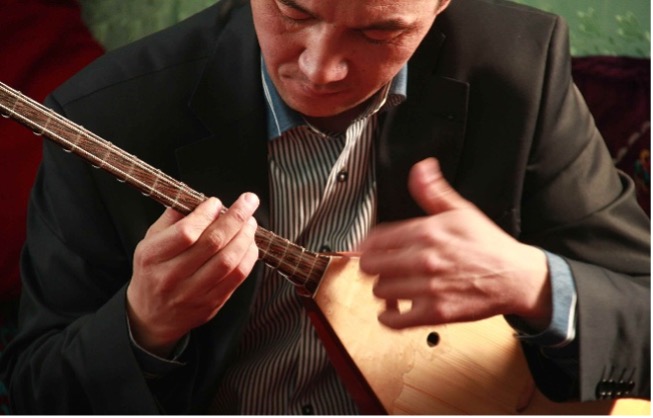
Traditional Knowledge and Skills in Making Kyrgyz and Kazakh Yurts (Turkic Nomad Dwellings) (2014)
A yurt is a nomadic dwelling common among the Kazakh and Kyrgyz people. It is a wooden round frame covered with felt and braided with ropes, and is easy to assemble and disassemble in a short period of time. The bearers of knowledge about the yurt are artisans - both men and women - who are engaged in the manufacture of yurt and interior items. Yurts are made from natural and renewable raw materials. Men and their apprentices handcraft wooden frames, as well as parts from wood, leather, bone and metal. Women are engaged in the interior decoration and exterior coating, decorating them with traditional zoomorphic, plant or geometric patterns. They typically work in community groups under the guidance of experienced craftswomen, using weaving, spinning, braiding, felting, embroidery, sewing and other traditional craft techniques. The entire community of craftsmen participates in the creation of yurts, which promotes the formation of common human values, constructive cooperation and creative imagination. Traditionally, knowledge and skills are passed on within the family or from teacher to student. All holidays, ceremonies, births, weddings and funeral rituals are held in the yurt. Thus, the yurt remains a symbol of family and traditional hospitality, which are fundamental to the identity of the Kazakh and Kyrgyz peoples.
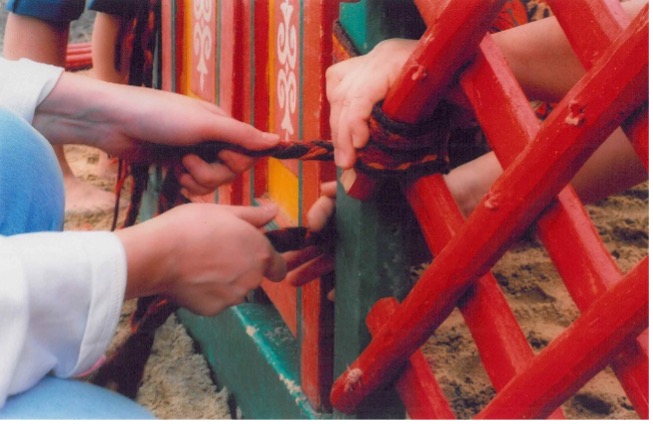
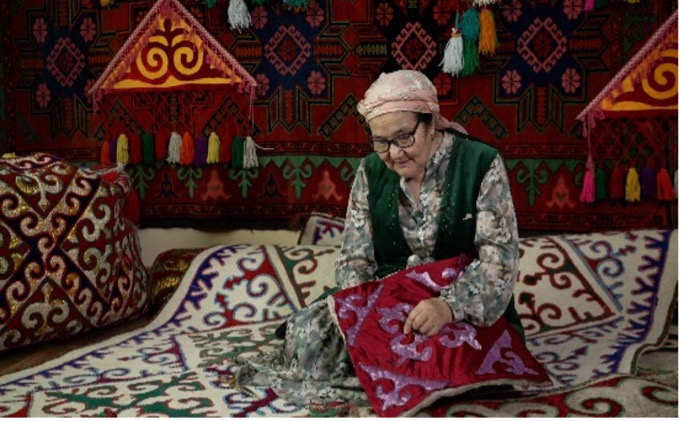
Aitys, the art of improvisation (2015)
Aitys is a competition of improvised oral poetry, recited or performed to the accompaniment of traditional musical instruments - the Kazakh dombra or the Kyrgyz komuz. In a battle of wits, two performers (akyn) compete with each other in improvising poems on topical issues, alternating between humorous remarks and heartfelt philosophical reflections. During the competition, performers sit opposite each other and improvise a dialogue on topics suggested by the audience. The winner is the performer who demonstrates the best musical skills, rhythms, originality, resourcefulness, wisdom and wit. The most meaningful and witty statements often become folk sayings. The competition is held on a variety of occasions, from local holidays to national events, where participants often use it as a platform to discuss important social issues. Although traditionally only men took part in the Aitysh/Aitys competition, many women now participate and use the competition to express female aspirations and points of view. Today, Aitysh/Aitys is a very popular cultural component of the multi-ethnic societies of Kyrgyzstan and Kazakhstan and represents an important part of the identity of the host communities. Senior performers teach and pass on their knowledge and skills to younger generations.
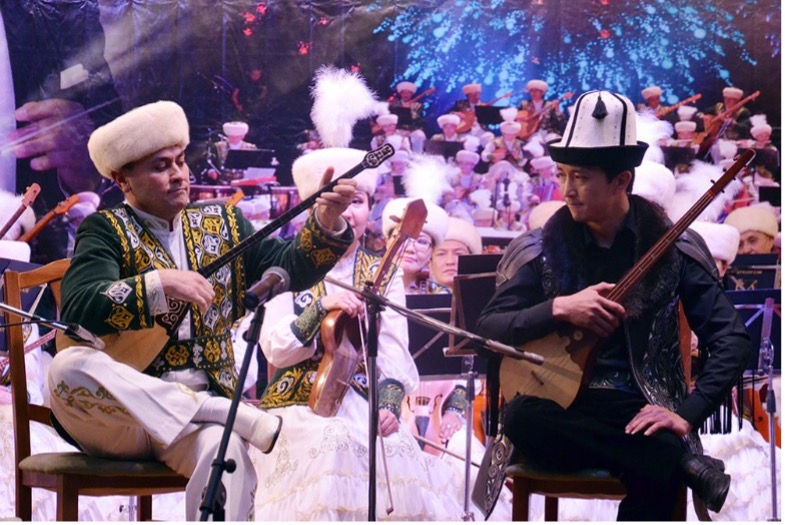
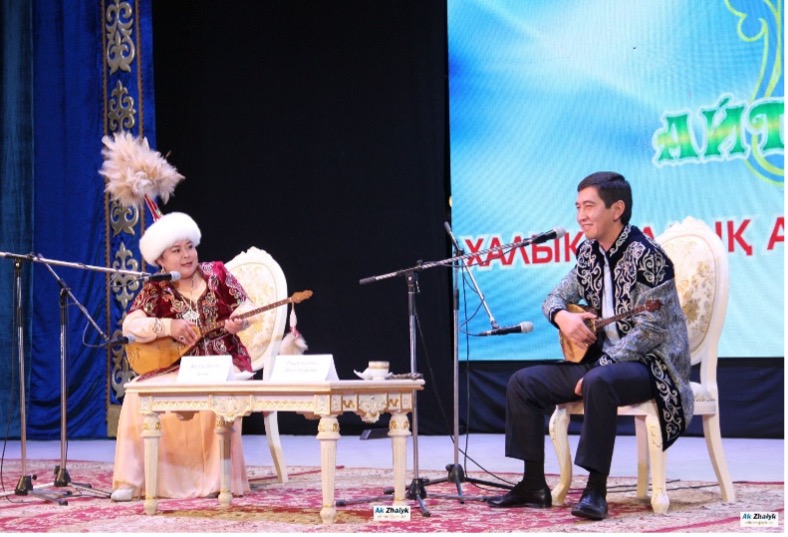
Kures in Kazakhstan (2016)
Kures in Kazakhstan is a form of wrestling in which participants compete on their feet, aiming to pin their opponent's shoulders to the ground. It is a traditional practice in which coaches train young boys, preparing them to participate in local competitions. Today, kures is a national sport in Kazakhstan, practiced by both men and women, up to the professional level. International competitions are also held, including the annual Kazakhstan Barysy tournament, broadcast in more than 100 countries around the world. The transmission of kures traditions in Kazakhstan takes place in sports clubs, which can be located at schools, as well as in master classes held by experienced wrestling coaches. The minimum age for students can be up to 10 years old, and there are no restrictions on the experience of participants. Kures also has its place in the traditional folklore of Kazakhstan. The wrestlers, known as baluans, were considered strong and courageous, and were depicted as such in epics, poetry, and literature. The practice of kures teaches the younger generation of Kazakhstan to respect their history and culture, and to aspire to be like the heroic baluans. It also promotes tolerance, goodwill, and solidarity between communities.
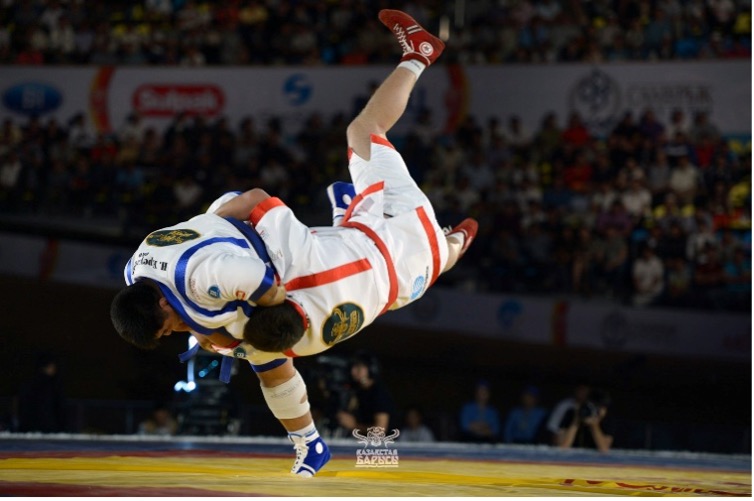
Flatbread Making and the Culture of Sharing: Lavash, Katırma, Yupka, Yufka (2016)
The culture of making and sharing flatbread in communities in Azerbaijan, Iran, Kazakhstan, Kyrgyzstan, and Turkey serves social functions that allow it to remain a widespread tradition. At least three people, most often family members, participate in the preparation of bread (lavash, katyrma, yupka, or yufka), each playing a role in its preparation and baking. In rural areas, neighbors participate in this process together. Traditional bakeries also make bread. It is baked in a tandoor (a clay or stone oven in the ground), on a sadj (metal plate), or in a kazan (cauldron). In addition to daily consumption, flatbread is served at weddings, childbirth, funerals, various holidays, and during prayers. In Azerbaijan and Iran, it is placed on the bride's shoulders or crumbs are scattered on her head as a symbol of well-being for the couple, while in Turkey it is given to the newlyweds' neighbors. At funerals in Kazakh society, flatbreads are often dedicated to the spirits of deceased loved ones and distributed in prayer for their ancestors, while in Kyrgyzstan, it is believed that sharing bread contributes to a better afterlife for the deceased. This practice, passed down within families and from master to apprentice, expresses hospitality, solidarity, and certain beliefs, symbolizing shared cultural roots and strengthening a sense of community.

Nauryz (2016)
Nauryz is a time of wishes for prosperity and new beginnings. March 21 marks the beginning of the year in regions of Afghanistan, Azerbaijan, India, the Islamic Republic of Iran, Iraq, Kazakhstan, Kyrgyzstan, Pakistan, Tajikistan, Turkey, Turkmenistan, and Uzbekistan. In each of these countries, the holiday is known as Navruz ("new day"), and has other names. This holiday includes many rituals, ceremonies, and other cultural events that take place over a period of about two weeks. One of the most important traditions is the gathering of family and loved ones around a festive "table" decorated with objects symbolizing purity, light, abundance, and prosperity. People wear new clothes, visit relatives, especially the elderly, and neighbors. Gifts are exchanged, especially items made by artisans. Street music and dance performances, community rituals involving water and fire, traditional sports and handicrafts are also held. These practices help to preserve cultural diversity, promote tolerance, solidarity and peace in society, which are passed on from older to younger generations through observation, participation and shared celebration.
Kazakh Traditional Asyk Games (2017)
Kazakh Traditional Asyk Games are an ancient tradition in Kazakhstan. Each player has a set of asyks, which are traditionally made from a ram’s talus, and a brightly painted saka. Players try to knock their opponents’ asyks off the playing field with their asyks, with the position of the dice after the throw being of great importance. The community of players includes most of the population of Kazakhstan, including members of the Asyk Atu Game Federation, as well as a wider community of practitioners, mostly children between the ages of four and eighteen. This game is an active recreational activity that promotes analytical thinking and physical fitness in children, friendship and social integration. It serves as an excellent model of positive interaction, uniting people regardless of their age, ethnicity or religion. The game is widely practiced at festive celebrations and gatherings, and the community plays a key role in preserving the practice, as well as popularizing it among other ethnic groups in Kazakhstan, turning it into a national symbol of childhood. It is passed on from older boys to younger ones through observation, radio programs and television documentaries aimed at attracting children to play asyk and introducing people to their cultural heritage.
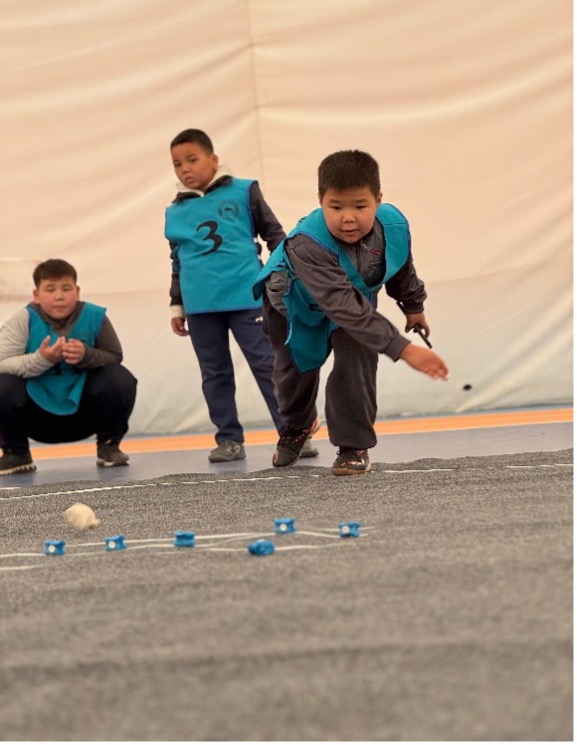

Traditional spring festive rites of Kazakh horse breeders
Traditional spring festive rites of Kazakh horse breeders, held in the village of Terisakkan, Ulytau district, Karaganda region, mark the end of the old and the beginning of a new annual horse breeding cycle. The rites, based on traditional knowledge about nature and the centuries-old relationship between man and horse, include skills inherited from nomadic ancestors and adapted to modern realities. The main components of the rite, which is preceded by a year of preparation, are: "Bie bailau" (literally - "tying up the mares") - an ancient rite of the "first milking", including the separation of mares and foals from the herd, milking the mares and celebrating with songs, dances and games; "Aigyr kosu" (figuratively - "marriage of a stallion") is a relatively new rite of introducing stallions into the herd; "Kymyz muryndyk" (metaphorically - "the appearance of the first kumys") is a rite of the "first exchange of kumys", opening the season of its production and exchange. The rites take about three weeks in total, until the end of the ceremonies of exchanging kumys, which are held in each family. The rites open a new annual cycle of reproduction and express traditional Kazakh hospitality. Faced with a forced transition from a nomadic to a sedentary lifestyle in the 20th century, the bearers of the traditional form of horse breeding adapted it to modern conditions in order to ensure its future viability.
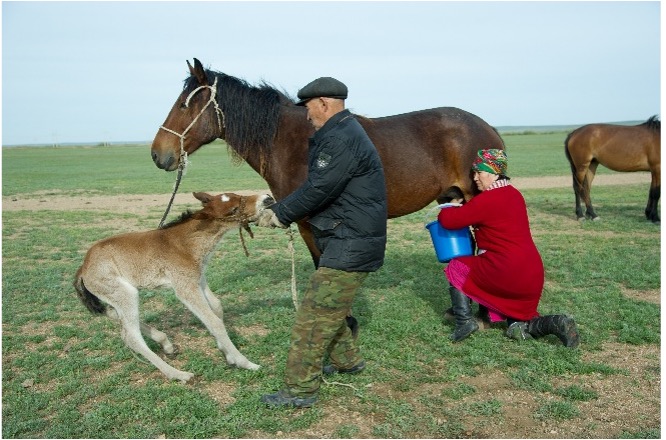
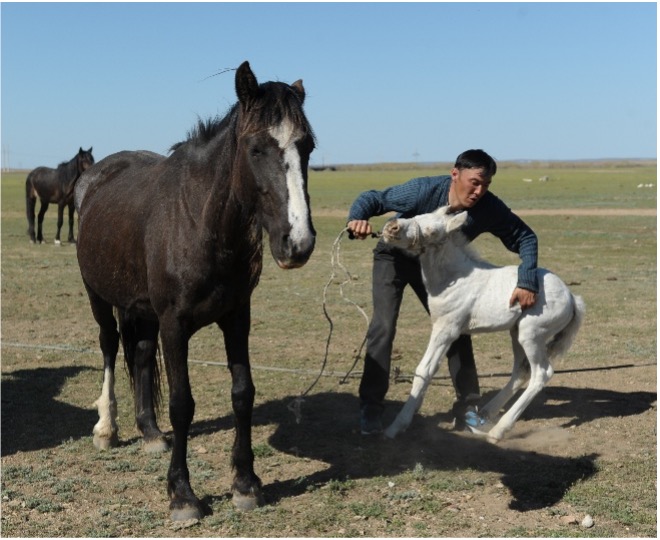
The Legacy of Dede Korkut/Korkyt Ata/Dede Korkut, Epic Culture, Folktales and Music (2018)
The Epic Culture, Folktales and Music of Dede Korkut/Korkyt Ata/Dede Korkut is based on twelve heroic legends, stories and tales, as well as thirteen traditional musical compositions passed down from generation to generation through oral tradition, performance art, cultural codes and musical compositions. Dede Korkut appears in each story as a legendary figure and a wise person, a sage and a minstrel, whose words, music and expressions of wisdom are linked to the traditions of birth, marriage and death. The main intonations in the musical compositions are reproduced on the kobyz musical instrument through the sounds of nature, with onomatopoeia being typical for this means (for example, imitation of a wolf howl or the cries of swans). Each composition is organically intertwined with the epic narrative that accompanies it. This element includes social, cultural and moral values such as heroism, dialogue, physical and spiritual health and unity, as well as respect for nature, and contains deep knowledge about the history and culture of Turkic-speaking communities. The practice is preserved and passed on by the community through numerous important events - from family holidays to national and international festivals - and is therefore firmly rooted in society, serving as a link between generations.
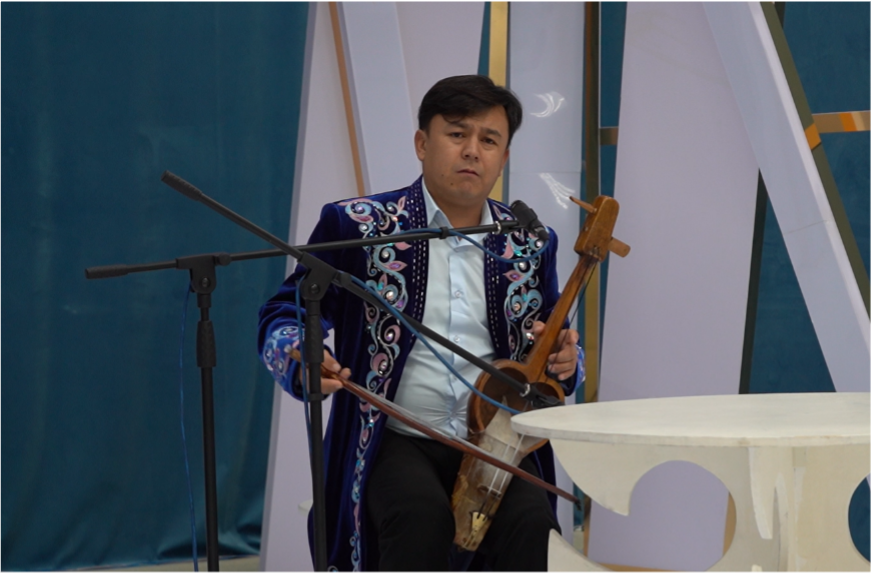
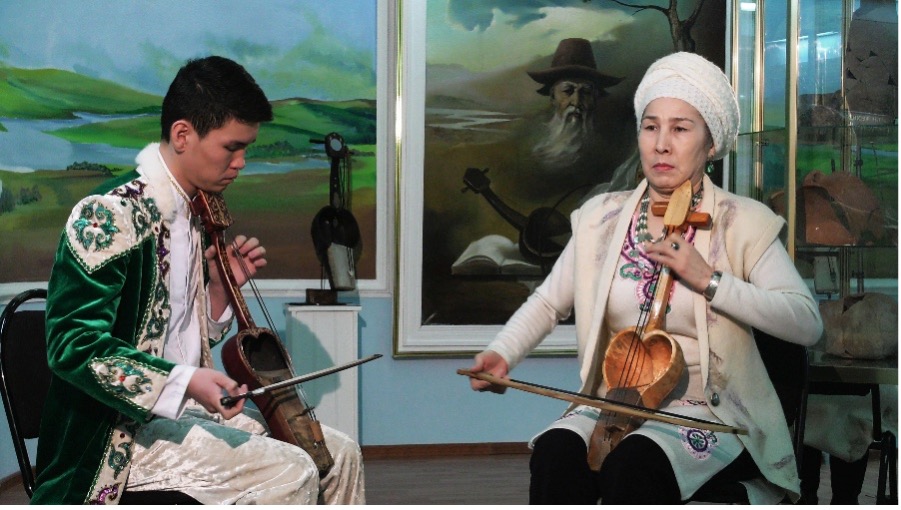
Traditional Intellectual Strategy Game: Toğızkumalak, Toğuz Korgul, Mangala/Göçürme (2020)
Traditional Intellectual Strategy Game: Toğızkumalak, Toğuz Korgul, Mangala/Göçürme is a traditional game that can be played on special boards or improvised fields, such as holes dug in the ground. The game can be played with balls made of stone, wood, metal and bone, nuts or seeds, which are placed in the holes; the player who collects the most balls wins the game. There are several variations of the game. For example, the board can have two, three, four, six or nine holes arranged in order depending on the number of players, which determines the duration of the game. In the countries represented, this element is associated with traditional crafts such as wood and stone carving and jewellery making. Wood and stone carvers and jewellers produce both elaborately decorated boards and marbles, as well as practical ones, reflecting traditional worldviews and their artistic creativity. The game develops players’ cognitive, motor and social skills, strategic and creative thinking, teaches them patience and attentiveness. It is transmitted both informally and within the framework of formal education. Recently, communities have developed mobile applications that allow the game to be learned and/or played, providing new ways to transmit skills and increase its popularity among younger generations.
Falconry - A Living Heritage of Humanity (2021)
Falconry is the traditional art and practice of training and domesticating falcons (and sometimes eagles, hawks and other birds of prey). It has been practiced for over 4,000 years. Falconry was known in the early and medieval periods in many parts of the world. Falconry was originally a way of obtaining food, but over time it was integrated into public life as a social and recreational practice, as well as a way of communicating with nature. Today, falconry is practiced by people of all ages in many countries. An important cultural symbol in many of these countries, it is passed down from generation to generation in a variety of ways, including mentoring, within families or in training clubs. Modern falconry practice aims to protect the falcons, quarries and habitats, as well as the practice itself. Although falconers come from diverse backgrounds, they share common values, traditions and practices, including breeding, training and care methods for birds, the equipment used and the relationship between falconer and bird. The falconry community includes support organisations such as falcon hospitals, breeding centres, conservation agencies and traditional equipment manufacturers.
The Nasreddin Khoja/Molla Nesreddin/Molla Ependi/Apendi/Afendi Kozhansır Joke-Telling Tradition (2022)
The Nasreddin Joke-Telling Tradition refers to the social practices and celebrations associated with telling jokes attributed to Nasreddin, a philosopher and sage known for his wisdom and humorous analysis and representation of society and life experiences. Although there are slight variations in the portrayals, character names, and plots across communities, the basic features are a common heritage across Azerbaijan, Kazakhstan, Kyrgyzstan, Tajikistan, Turkey, Turkmenistan, and Uzbekistan. The jokes are passed down through oral tradition and written sources, becoming a source of local idioms and proverbs. Many of them have become classics and are also distributed in print and visual media, as well as in children's television programs. Characterized by wisdom, wit, absurdity and the unexpected, Nasreddin's jokes often break with accepted norms, with the teller finding unexpected solutions to difficult situations and always emerging victorious through the power of words. Jokes serve an educational and entertaining function, and communities use them to enrich conversations, strengthen arguments, persuade others or explain situations. Municipalities, universities and non-governmental organizations play an important role in transmitting jokes by organizing various events and festivals at the local, national and international levels.
Orteke, a Traditional Performing Art in Kazakhstan: Dance, Puppets and Music (2022)
Orteke is a traditional Kazakh performing art that combines theatre, music and puppetry. This folk art combines playing the dombra, a traditional two-string instrument, with the dance of a wooden puppet. Attached to the surface of a traditional drum with a metal rod, a wooden figure in the form of a mountain goat is connected to the musician’s fingers by one or more strings. When the musician strikes the strings of the dombra, the puppet comes to life, jumping up and down in time to the music and beating rhythmic blows on the drum. Some masters can play with three or more figures simultaneously. This performance, captivating in its simplicity, is enjoyed by both children and adults. It is passed on mainly within communities and through apprenticeships, although the Kokil Music College in Almaty also has a group of researchers involved in the art. The biennial Orteke International Festivals and regional puppet art competitions are another platform for learning and exchanging skills and experiences between puppet artists from Kazakhstan and neighboring countries. An important part of the region's folk heritage and identity, Orteke also serves as a means of communication between adults and children.
Betashar - Traditional Wedding Ritual (2024)
In Kazakhstan, the Betashar ritual is a ceremony of revealing the bride's face during a wedding ceremony. It originated in the Middle Ages, when the groom rarely saw his future bride before the wedding. At the beginning of the ceremony, the bride's mother puts a traditional Kazakh headdress and veil on her. She is escorted to the hall, where guests await her appearance. The akyn (singer and host of the ceremony) begins a wedding song, praising the groom's family and ancestors. As a sign of respect and greeting, the bride and her daughters-in-law bow to each person when they are mentioned. Then the "akyn" lifts the bride's veil, revealing her face to the guests. The groom's mother welcomes her daughter-in-law as a new member of the family, and the groom takes her hand. Then the relatives shower the newlyweds with sweets and coins. Social norms and knowledge associated with Betashar are passed down from grandmothers to grandchildren. Akyns and artisans who create traditional wedding dresses and accessories pass on their knowledge through apprenticeships. The ritual brings new family members and neighbors together. It also allows for the exchange of traditional knowledge, such as folk songs, strengthening mutual understanding and dialogue.